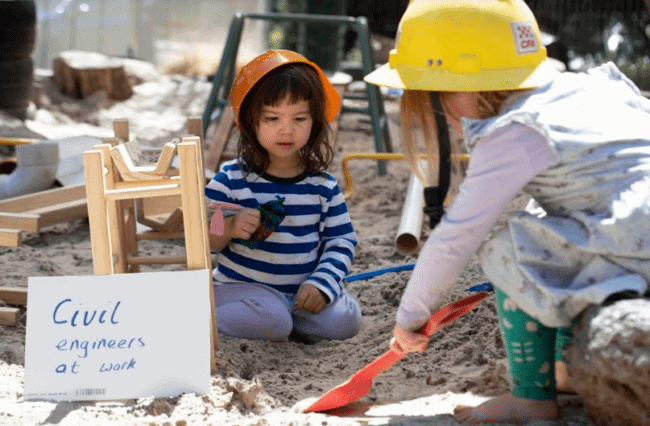ABSTRACT
Expectations for increased conceptual outcomes in the early childhood education sector have foregrounded a need for more evidenced-based practice in support of children’s play. One such avenue for researching models of play practices that support cognitive outcomes is to study the implementation of Playworlds. Grounded in cultural-historical theory, Playworlds is a model of play pedagogy where children and educators recreate a narrative through dramatization.
However, this approach has not traditionally been linked with enhanced academic outcomes. In this study, the researchers used executive functions (EFs) as a pre and post measure for studying the potential development of the learner. As a potential evidenced-based model of practice, we examined the effect of incorporating EF tasks into early childhood programs through Playworlds. Specifically, EFs were incorporated into everyday practices within eight play-based preschool programs in Victoria, Australia, through Playworlds and associated activities. Ninety-one preschool aged children (50% male, M = 54.7 months, SD = 3.94) participated.
Video observations and interviews documented teaching practices related to the incorporation of EFs into play-based programs. Findings document gains in EF skills in the context of the Playworld practices. Snapshots of teaching practices provide guidelines for incorporating EFs into early childhood play-based programs.
Read the Research
References:
- Barkley, R. A. 2001. “The EF and Self-regulation: An Evolutionary Neuropsychological Perspective.” Neuropsychology Review 11: 1–29. doi:10.1023/A:1009085417776. [Crossref], [PubMed], [Web of Science ®], [Google Scholar]
- Bierman, K. L. , and M.Torres . 2016. “Promoting the Development of Executive Functions through Early Education and Prevention Programs.” In Executive Function in Preschool-age Children: Integrating Measurement, Neurodevelopment, and Translational Research , edited by J. A.Griffin, P.McCardle, and L. S.Freund , 299–326. Washington, DC, US: American Psychological Association. [Crossref], [Google Scholar]
- Blair, C. , P. D.Zelazo, and M. T.Greenberg . 2005. “The Measurement of Executive Function in Early Childhood.” Developmental Neuropsychology 28 (2): 561–571. doi:10.1207/s15326942dn2802_1. [Taylor & Francis Online], [Web of Science ®], [Google Scholar]
- Blakey, E. , and D. J.Carroll . 2015. “A Short Executive Function Training Program Improves Preschoolers’ Working Memory.” Frontier in Psychology 6: 1–8. doi:10.3389/fpsyg.2015.01827. [Crossref], [PubMed], [Web of Science ®], [Google Scholar]
- Bull, R. , K. A.Espy, and S. A.Wiebe . 2008. “Short-term Memory, Working Memory, and Executive Functioning in Preschoolers: Longitudinal Predictors of Mathematical Achievement at Age 7 Years.” Developmental Neuropsychology 33 (3): 205–228. doi:10.1080/87565640801982312. [Taylor & Francis Online], [Web of Science ®], [Google Scholar]
- Cantin, R. H. , E. K.Gnaedinger, K. C.Gallaway, M. S.Hesson-McInnis, and A. M.Hund . 2016. “Executive Functioning Predicts Reading, Mathematics, and Theory of Mind during the Elementary Years.” Journal of Experimental Child Psychology 146: 66–78. doi:10.1016/j.jecp.2016.01.014. [Crossref], [PubMed], [Web of Science ®], [Google Scholar]
- Department of Education and Training . 2009. “Belonging, Being & Becoming – the Early Years Learning Framework for Australia.” https://docs.education.gov.au/system/files/doc/other/belonging_being_and_becoming_the_early_years_learning_framework_for_australia._v5_docx.pdf [Google Scholar]
- Diamond, A. , and D. S.Ling . 2016. “Conclusions about Interventions, Programs, and Approaches for Improving Executive Functions that Appear Justified and Those That, despite Much Hype, Do Not.” Developmental Cognitive Neuroscience 18: 34–48. doi:10.1016/j.dcn.2015.11.005. [Crossref], [PubMed], [Web of Science ®], [Google Scholar]
- Early Childhood Australia . 2014. “National Quality Standard Professional Learning Program: Being Intentional.” (No. 72). http://www.earlychildhoodaustralia.org.au/nqsplp/wp-content/uploads/2014/03/NQS_PLP_E-Newsletter_No72.pdf [Google Scholar]
- Fagot, B. I. , and M.Gauvain . 1997. “Mother-child Problem Solving: Continuity through the Early Childhood Years.” Developmental Psychology 33 (3): 480–488. doi:10.1037//0012-1649.33.3.480. [Crossref], [PubMed], [Web of Science ®], [Google Scholar]
- Ferholt, B. 2010. “A Synthetic-analytic Method for the Study of Perezhivanie. Vygotsky’s Literary Analysis Applied to Playworlds.” In Vygotsky and Creativity , edited by M. C.Connery, V. P.John-Steiner, and A.Marjanovic-Shane , 163–179. New York, USA: Peter Lang. [Google Scholar]
- Ferholt, B. , and R.Lecusay . 2009. “Adult and Child Development in the Zone of Proximal Development: Socratic Dialogue in a Playworld.” Mind, Culture and Activity 17 (1): 59–83. doi:10.1080/10749030903342246. [Taylor & Francis Online], [Web of Science ®], [Google Scholar]
- Fitzpatrick, C. , R. D.McKinnon, C. B.Blair, and M. T.Willoughby . 2014. “Do Preschool Executive Function Skills Explain the School Readiness Gap between Advantaged and Disadvantaged Children?” Learning and Instruction 30: 25–31. doi:10.1016/j.learninstruc.2013.11.003. [Crossref], [Web of Science ®], [Google Scholar]
- Fleer, M. 2017. “Digital Playworlds in an Australia Context.” In Routledge Handbook of Play in Early Childhood , edited by T.Bruce, M.Bredikyte, and P.Hakkarainen , 289–304. UK: Routledge Press, Taylor and Francis Group. [Crossref], [Google Scholar]
- Fleer, M. , and B.van Oers . 2018. “International Trends in Research: Redressing the North-south Balance in What Matters for Early Childhood Education Research.” In International Handbook on Early Childhood Education , edited by M.Fleer and B.van Oers , 1–31. Vol. 1. The Netherlands: Springer. [Crossref], [Google Scholar]
- Fleer, M. 2018a. “The Role of Subjectivity in Understanding Teacher Development in a Scientific Playworld: The Emotional and Symbolic Nature of Being a Teacher of Science.” In Theory of Subjectivity: New Perspectives within Social and Educational Research , edited by F.González Rey, A. M.Martinez, and D. M.Goulart, 149–164 . The Netherlands: Springer. [Google Scholar]
- Fleer, M. 2018b. “Conceptual Playworlds.” //www.monash.edu/conceptual-playworld [Google Scholar]
- Fleer, M. 2019. “Conceptual Playworlds: The Role of Imagination in Play and Imagination in Learning.” Early Years: An International Research Journal . doi:10.1080/09575146.2018.1549024. [Taylor & Francis Online], [Google Scholar]
- Fleer, M. 2019. “Scientific Playworlds: A Model of Teaching Science in Play-based Settings.” Research in Science Education 1–22. doi:10.1007/s11165-017-9653-z. [Crossref], [Web of Science ®], [Google Scholar]
- Fleer, M. , N.Veresov, C.Harrison, and S.Walker . 2017. “Working with Teachers’ Pedagogical Strengths: The Design of Executive Function Activities for Play-based Programs.” Australasian Journal of Early Childhood 42 (4): 47–55. doi:10.23965/AJEC.42.4.06. [Crossref], [Web of Science ®], [Google Scholar]
- Fleer, M. , N.Veresov, and S.Walker . 2017. “Re-conceptualizing Executive Functions as Social Activity in Children’s Playworlds.” Learning, Culture and Social Interaction 14: 1–11. doi:10.1016/j.lcsi.2017.04.003. [Crossref], [Web of Science ®], [Google Scholar]
- Frye, D. , P. D.Zelazo, and T.Palfai . 1995. “Theory of Mind and Rule-based Reasoning.” Cognitive Development 10: 483–527. doi:10.1016/0885-2014-(95)90024-1s. [Crossref], [Web of Science ®], [Google Scholar]
- Gerstadt, C. L. , Y. J.Hong, and A.Diamond . 1994. “The Relationship between Cognition and Action: Performance of Children 3½– 7 Years Old on a Stroop-like Day–night Test.” Cognition 53 (2): 129–153. doi:10.1016/0010-0277(94)90068-X. [Crossref], [PubMed], [Web of Science ®], [Google Scholar]
- Hakkarainen, P. , and M.Bredikyte . 2008. “The Zone of Proximal Development in Play and Learning.” Cultural-Historical Psychology 4: 2–11. http://lchc.ucsd.edu/mca/Mail/xmcamail.2010_12.dir/pdf6DAHjotjsS.pdf [Google Scholar]
- Hedegaard, M. 2008. “The Educational Experiment.” In Studying Children: A Cultural Historical Perspective , edited by M.Hedegaard and M.Fleer , 181–201. New York, NY: Open University Press. [Google Scholar]
- Lindqvist, G. 1995. The Aesthetics of Play: A Didactic Study of Play and Culture in Preschools . Stockholm, Sweden: Gotab. [Google Scholar]
- Luria, A. R. 1973. The Working Brain: An Introduction to Neuropsychology . New York: Basic Books. [Google Scholar]
- Rainio, A. P. 2008. “Developing the Classroom as a Figured World.” Journal of Educational Change 9 (4): 357–364. doi:10.1007/s10833-008-9083-9. [Crossref], [Google Scholar]
- Raver, C. C. , S. M.Jones, C.Li-Grining, F.Zhai, K.Bub, and E.Pressler . 2011. “CSRP’s Impact on Low-income Preschoolers’ Preacademic Skills: Self-regulation as a Mediating Mechanism.” Child Development 82 (1): 362–378. doi:10.1111/j.1467-8624.2010.01561.x. [Crossref], [PubMed], [Web of Science ®], [Google Scholar]
- Rothlisberger, M. , R.Neuenschwander, P.Cimeli, E.Michel, and C. M.Roebers . 2011. “Improving Executive Functions in 5- and 6-year-olds: Evaluation of a Small Group Intervention in Prekindergarten and Kindergarten Children.” Infant and Child Development 21 (4): 411–429. doi:10.1002/icd.752. [Crossref], [Web of Science ®], [Google Scholar]
- Sasser, T. R. , K. L.Bierman, and B.Heinrichs . 2015. “Executive Functioning and School Adjustment: The Mediational Role of Pre-kindergarten Learning-related Behaviors.” Early Childhood Research Quarterly 30: 70–79. doi:10.1016/j.ecresq.2014.09.001. [Crossref], [PubMed], [Web of Science ®], [Google Scholar]
- Ursache, A. , C.Blair, and C.Raver . 2011. “School Readiness and Early Achievement in Children at Risk for School Failure.” Child Development Perspectives 6 (2): 122–128. doi:10.1111/j.1750-8606.2011.00209.x. [Crossref], [Web of Science ®], [Google Scholar]
- Visu-Petraa, L. , L.Cheiea, O.Bengaa, and M.Micleab . 2011. “Cognitive Control Goes to School: The Impact of Executive Functions on Academic Performance.” Procedia Social and Behavioural Sciences 11: 240–244. doi:10.1016/j.sbspro.2011.01.069. [Crossref], [Google Scholar]
- Vygotsky, L. S. 1966. “Play and Its Role in the Mental Development of the Child.” Voprosy Psikhologii 12 (6): 62–76. doi:10.2753/RPO1061-040505036. [Taylor & Francis Online], [Google Scholar]
- Walker, S. , M.Fleer, N.Veresov, and I.Duhn . 2020. “Enhancing Executive Function through Imaginary Play: A Promising New Practice Principle.” Australasian Journal of Early Childhood 45 (2): 114–126. doi:10.1177/1836939120918502. [Crossref], [Web of Science ®], [Google Scholar]
- Zelazo, P. D. 2006. “The Dimensional Change Card Sort (DCCS): A Method of Assessing Executive Function in Children.” Nature Protocols 1 (1): 297–301. doi:10.1038/nprot.2006.46. [Crossref], [PubMed], [Web of Science ®], [Google Scholar]

